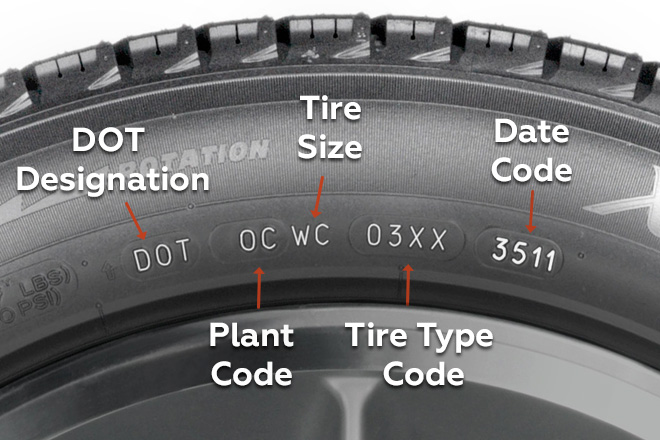The sidewall of a tire may look like a jumble of letters, numbers, and symbols to the untrained eye, but these markings carry valuable information. Understanding your tire markings is essential for vehicle safety, performance, and ensuring that you’re using the right tires for your car. From the tire’s size to load capacity and speed ratings, each marking plays a critical role in maintaining your vehicle’s optimal performance.
In this article, we will decode these tire markings, helping you uncover the secrets that can lead to better driving decisions, improved safety, and greater fuel efficiency.
What Are Tire Markings?

Tire markings are the series of letters and numbers located on the sidewall of a tire, containing crucial information such as the tire’s size, load index, speed rating, and other performance attributes. These markings are standardized, allowing manufacturers and drivers worldwide to communicate vital tire data easily.
Understanding tire markings allows you to make informed decisions when purchasing new tires, maintain proper tire care, and ensure that your vehicle meets safety standards.
Decoding Tire Markings: What Each Symbol Means
Let’s break down the most important tire markings you’ll find on your tire’s sidewall and explain what each one represents.
1. Tire Size
One of the most important aspects of tire markings is the size designation. A typical tire size might look like this: P225/60R16. Each part of this sequence tells you something about the tire’s physical dimensions and construction:
- P: This stands for “passenger vehicle.” Other designations include LT (light truck) and T (temporary or spare tires).
- 225: This number represents the tire’s width in millimeters from sidewall to sidewall. In this example, the tire is 225 millimeters wide.
- 60: The second number is the aspect ratio, which indicates the tire’s height as a percentage of its width. In this case, the tire’s height is 60% of its width.
- R: The “R” stands for radial construction, the most common tire construction type.
- 16: This refers to the diameter of the wheel (rim) that the tire fits, measured in inches. In this example, the tire is designed to fit a 16-inch wheel.
Understanding your tire’s size is crucial for selecting replacements that fit your vehicle properly and ensure safe driving performance.
2. Load Index
The load index is a number found after the tire size code that indicates how much weight the tire can support when fully inflated. For example, a load index of 91 means the tire can support up to 1,356 pounds (615 kilograms). Higher numbers correspond to higher weight capacities.
It’s important to match the tire’s load index to your vehicle’s specifications to avoid overloading your tires, which can lead to dangerous situations such as blowouts or uneven tire wear.
3. Speed Rating
The speed rating is a letter found after the load index, indicating the maximum speed at which the tire can safely operate. Common speed ratings include:
- S: 112 mph (180 km/h)
- T: 118 mph (190 km/h)
- H: 130 mph (210 km/h)
- V: 149 mph (240 km/h)
Each letter represents the tire’s capability to withstand heat and stress at different speeds. If you regularly drive at high speeds, especially on highways, ensuring your tires have an adequate speed rating is crucial for safe performance.
4. Treadwear, Traction, and Temperature Grades
On most tires, you’ll find additional tire markings related to performance, including treadwear, traction, and temperature grades. These are part of the Uniform Tire Quality Grading (UTQG) system, and they provide insight into how well the tire will perform under certain conditions.
- Treadwear: This number is a relative indicator of the tire’s durability. A treadwear rating of 300, for example, means the tire should last three times as long as a control tire rated 100.
- Traction: Traction grades (AA, A, B, C) indicate the tire’s ability to stop on wet surfaces, with AA being the highest grade.
- Temperature: The temperature grade (A, B, C) indicates the tire’s resistance to heat buildup, important for high-speed driving.
These ratings are useful when comparing tires to find one that suits your driving conditions, particularly if you frequently drive in wet or hot environments.
5. DOT Code
The DOT (Department of Transportation) code found on your tire indicates that it complies with all federal safety standards. The last four digits of the DOT code are especially important because they reveal the tire’s manufacturing date. For example, a code ending in 3819 means the tire was manufactured in the 38th week of 2019.
This information helps determine the tire’s age, which is critical for safety. Even if a tire looks unused, it can degrade over time, and most experts recommend replacing tires that are six years old or older, regardless of tread wear.
6. Maximum Inflation Pressure
Your tire’s sidewall also includes the maximum inflation pressure, usually in pounds per square inch (PSI). This is the highest pressure the tire can safely handle. However, it’s essential to note that this is not the recommended driving pressure. Always check your vehicle’s manual for the correct tire pressure for everyday use.
Proper inflation is critical for maintaining tire markings performance. Overinflated or underinflated tires can negatively affect handling, increase tire wear, and reduce fuel efficiency.
Why Understanding Tire Markings Matters
Now that you understand how to read your tire markings, it’s essential to grasp why this knowledge matters. Properly interpreting these codes ensures you select the right tires for your vehicle, driving style, and typical road conditions.
1. Safety
Your tires are the only part of your vehicle that makes direct contact with the road, and having the right tires for your vehicle’s weight, speed, and load capacity is crucial. By understanding your tire markings, you ensure that you’re driving on tires that can handle the demands of your daily commute, long-distance road trips, or off-road adventures. Mismatched tires can lead to reduced traction, longer stopping distances, or even blowouts.
2. Performance
Different tires are designed for different driving conditions and performance requirements. For example, some tires are built for high-speed performance, while others are designed for maximum durability and tread life. Knowing how to read tire markings allows you to choose tires that best match your needs, whether that’s for fuel efficiency, handling, or durability.
3. Cost Savings
By understanding your tire’s treadwear rating, you can make more informed decisions about long-term savings. While tires with higher treadwear ratings may cost more upfront, they often last longer, meaning fewer replacements and lower long-term costs. Similarly, choosing tires with the correct load index and speed rating ensures they wear evenly, reducing the need for premature replacements.
How to Use Tire Markings When Shopping for New Tires
When it’s time to replace your tires, having a solid understanding of your tire markings can help you make an informed choice. Before heading to a tire shop or searching online, note your current tire’s size, load index, speed rating, and any additional performance specifications like treadwear or traction ratings.
Knowing this information allows you to compare options confidently, ensuring that your new tires match your vehicle’s needs and your driving habits. Whether you’re looking for performance tires for a sports car, durable all-season tires for a family sedan, or fuel-efficient tires for long-distance travel, tire markings provide the key to making the best decision.
Maximizing Your Tire’s Lifespan with Proper Care
Once you’ve decoded your tire markings and selected the right tires, proper care is essential for maximizing their lifespan. Regularly check your tire pressure to maintain optimal inflation, rotate your tires to promote even wear, and inspect your tires for signs of damage or excessive tread wear.
Tires that are properly cared for will not only last longer but also provide better fuel efficiency, improved handling, and enhanced safety. Monitoring tread depth and replacing tires when they become too worn ensures you’re always driving on safe, reliable tires.
The Hidden Value in Your Tire Markings
Your tire markings hold the key to a safer, more efficient, and cost-effective driving experience. By learning how to read and interpret these markings, you empower yourself to make smarter decisions about tire selection, maintenance, and replacement. Whether you’re preparing for a long road trip or simply looking to improve everyday driving performance, decoding your tire’s sidewall can make all the difference.
Understanding the secrets hidden in your tire markings helps you take control of your vehicle’s performance, ensuring that you’re always driving on tires that meet your needs and maximize your vehicle’s potential.










